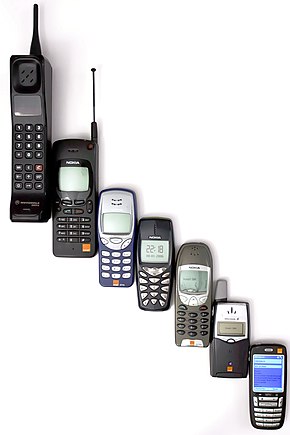
Infrastructure
Mobile phones communicate with cell towers that are placed to give coverage across a telephone service area, which is divided up into 'cells'. Each cell uses a different set of frequencies from neighboring cells, and will typically be covered by three towers placed at different locations. The cell towers are usually interconnected to each other and the phone network and the internet by wired connections. Due to bandwidth limitations each cell will have a maximum number of cell phones it can handle at once. The cells are therefore sized depending on the expected usage density, and may be much smaller in cities. In that case much lower transmitter powers are used to avoid broadcasting beyond the cell.

In order to handle the high traffic, multiple towers can be set up in the same area (using different frequencies). This can be done permanently or temporarily such as at special events like at the Super Bowl, Taste of Chicago, State Fair, NYC New Year's Eve, hurricane hit cities, etc. where cell phone companies will bring a truck with equipment to host the abnormally high traffic with a portable cell.
Cellular can greatly increase the capacity of simultaneous wireless phone calls. While a phone company for example, has a license to 1,000 frequencies, each cell must use unique frequencies with each call using one of them when communicating. Because cells only slightly overlap, the same frequency can be reused. Example cell one uses frequency 1–500, next door cell uses frequency 501–1,000, next door can reuse frequency 1–500. Cells one and three are not "touching" and do not overlap/communicate so each can reuse the same frequencies.[citation needed]
This is even more greatly increased when phone companies implemented digital networks. With digital, one frequency can host multiple simultaneous calls increasing capacity even more.
As a phone moves around, a phone will "hand off" - automatically disconnect and reconnect to the tower of another cell that gives the best reception.
Additionally, short-range Wi-Fi infrastructure is often used by smartphones as much as possible as it offloads traffic from cell networks on to local area networks.

"Cell phone" redirects here. For the film, see Cell Phone (film).
A mobile phone, cellular phone, cell phone, cellphone, handphone, or hand phone, sometimes shortened to simply mobile, cell or just phone, is a portable telephone that can make and receive calls over a radio frequency link while the user is moving within a telephone service area. The radio frequency link establishes a connection to the switching systems of a mobile phone operator, which provides access to the public switched telephone network (PSTN). Modern mobile telephone services use a cellular network architecture and, therefore, mobile telephones are called cellular telephones or cell phones in North America. In addition to telephony, digital mobile phones (2G) support a variety of other services, such as text messaging, MMS, email, Internet access, short-range wireless communications (infrared, Bluetooth), business applications, video games and digital photography. Mobile phones offering only those capabilities are known as feature phones; mobile phones which offer greatly advanced computing capabilities are referred to as smartphones.[1]
The development of metal-oxide-semiconductor (MOS) large-scale integration (LSI) technology, information theory and cellular networking led to the development of affordable mobile communications.[1] The first handheld mobile phone was demonstrated by John F. Mitchell[2][3] and Martin Cooper of Motorola in New York City in 1973, using a handset weighing c. 2 kilograms (4.4 lbs).[4] In 1979, Nippon Telegraph and Telephone (NTT) launched the world's first cellular network in Japan.[citation needed] In 1983, the DynaTAC 8000x was the first commercially available handheld mobile phone. From 1983 to 2014, worldwide mobile phone subscriptions grew to over seven billion; enough to provide one for every person on Earth.[5] In the first quarter of 2016, the top smartphone developers worldwide were Samsung, Apple and Huawei; smartphone sales represented 78 percent of total mobile phone sales.[6] For feature phones (slang: "dumbphones") as of 2016, the top-selling brands were Samsung, Nokia and Alcatel.[7]
About
This just a demo text widget, you can use it to create an about text, for example.
Popular
-
"Cell phone" redirects here. For the film, see Cell Phone (film) . "Handphone" redirects here. For the film, see Ha...
-
Infrastructure Mobile phones communicate with cell towers that are placed to give coverage across a telephone service area, which is di...




















